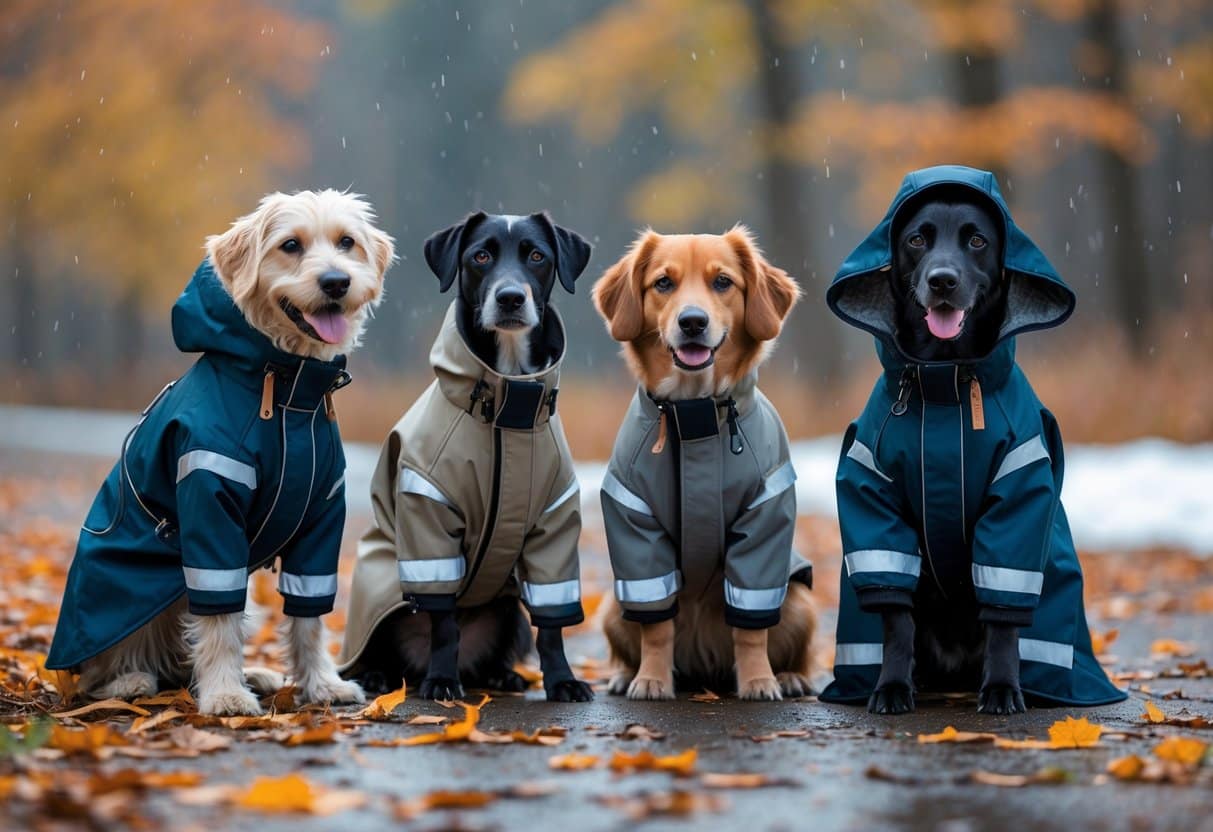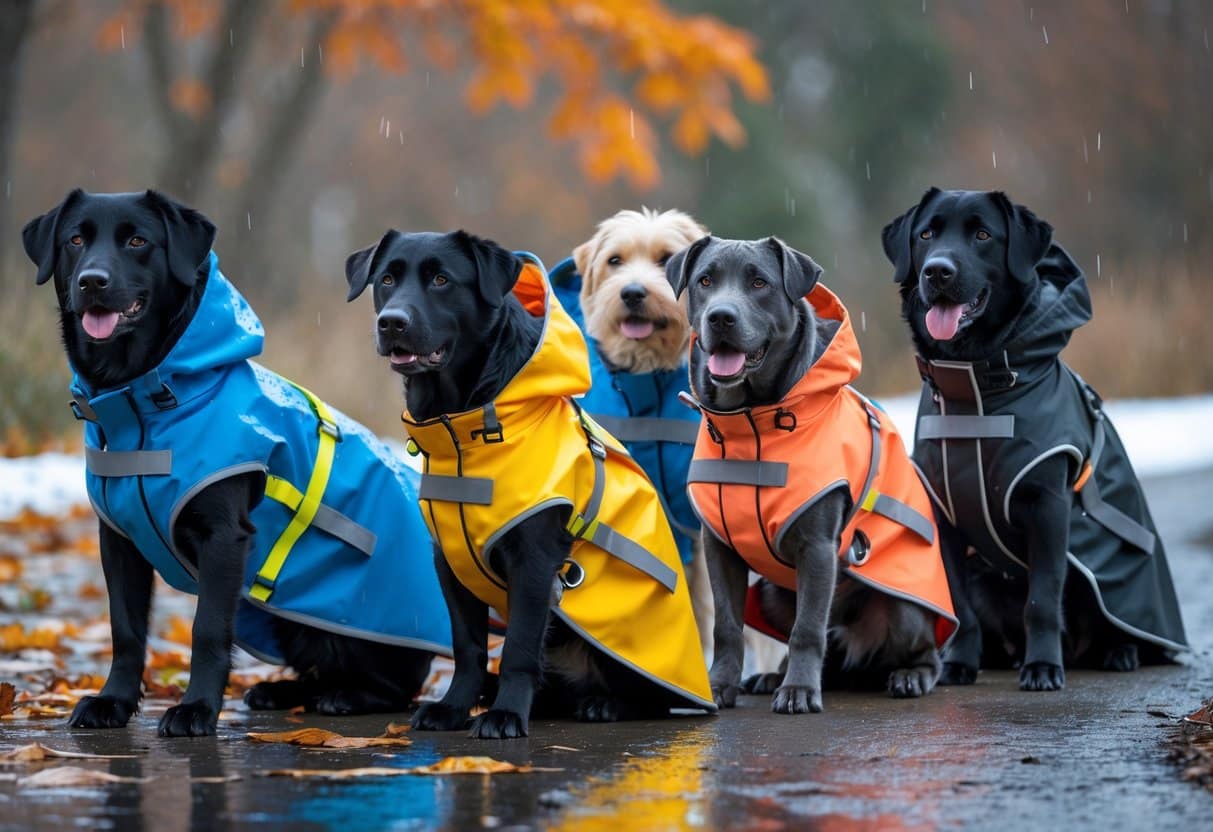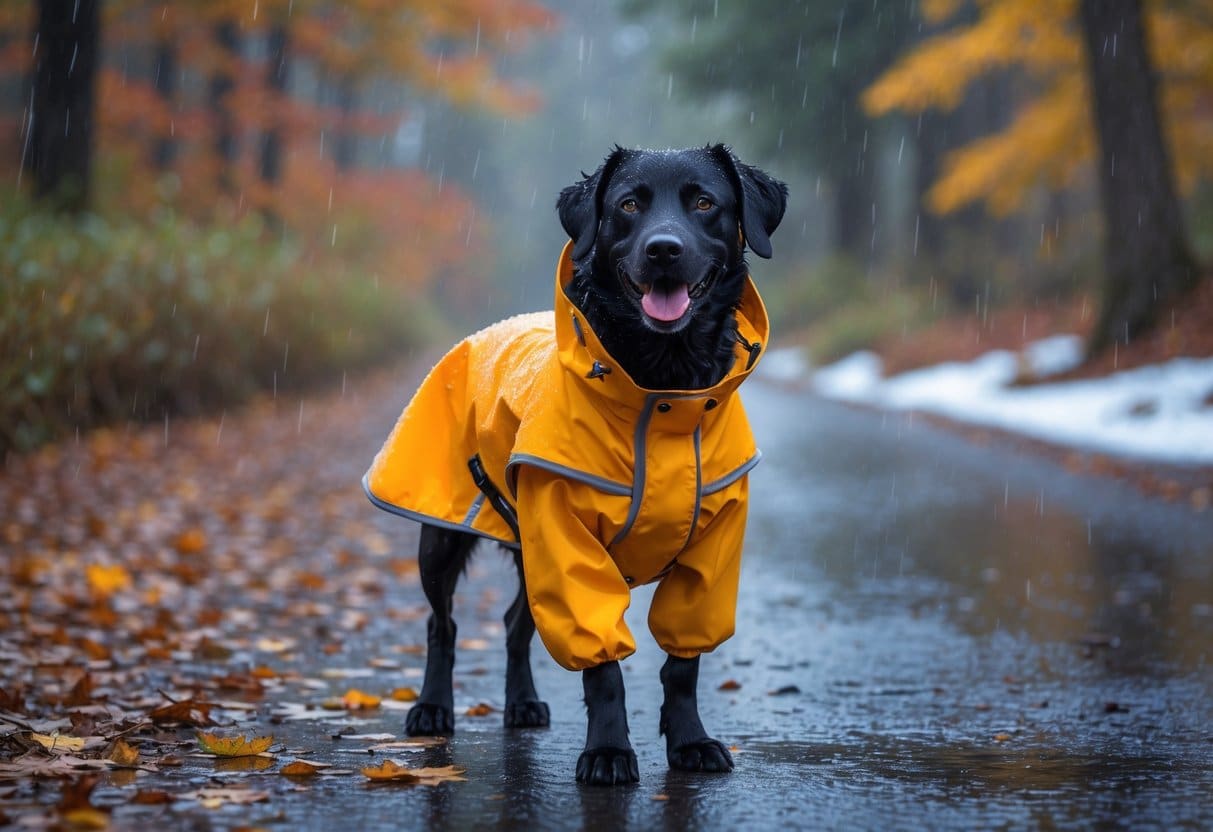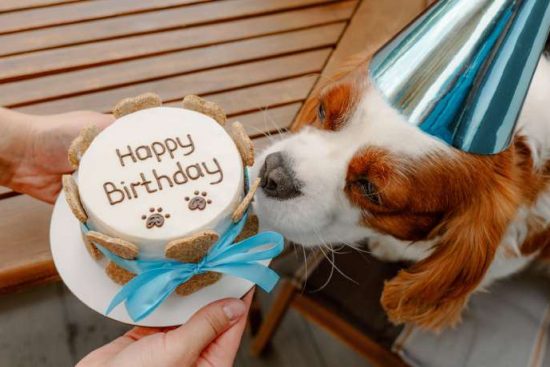
When fall rain turns into winter snow, keeping dogs dry and warm jumps to the top of the list for most pet owners. The best waterproof dog coats blend water-resistant shells with insulating layers to shield against both wet and cold weather.
Top-rated waterproof dog coats for 2025 bring together features like breathable fabrics, adjustable fits, and tough construction that actually holds up.
Not every dog needs a winter coat, but for some breeds, it can make a huge difference. Small dogs, short-haired pups, and seniors often have a harder time staying warm when the weather turns nasty.
Dogs that are lean, small, or puppies just can’t hold onto their body heat as well and really do benefit from an extra layer when they’re outside.
The right waterproof coat can make winter walks way more bearable for everyone involved. Leash portals, reflective trim, and machine-washable fabrics aren’t just nice—they’re practical, and you’ll notice the difference pretty quickly.
Jackets with waterproof or water-resistant shells simply outperform fleece when it comes to keeping your dog dry through rain or snow.
Key Takeaways
- Waterproof dog coats with insulation give the best shot at staying dry and warm in fall and winter
- Small breeds, short-haired dogs, and seniors really do get the most out of solid winter outerwear
- Look for water-resistant shells, adjustable fits, and handy features like leash portals
Why Waterproof Dog Coats Matter in Fall and Winter
Wet weather can turn a decent walk into a soggy mess for both you and your dog. A good waterproof coat keeps pets protected from the cold and helps avoid health problems tied to dampness.
Protection from Rain, Snow, and Cold
Water resistance is key for helping dogs hold onto their body heat during wet days. When a dog’s fur gets soaked, it basically loses its natural insulation, and that can lead to real trouble like hypothermia.
A waterproof coat acts as a shield between your dog and all that moisture. This becomes especially important when temps dip below 40-45°F—sometimes sooner if your pup is especially sensitive.
Snow and sleet aren’t just wet; they stick to fur and can freeze into little ice balls that are a pain to get out. Dog winter coats with solid waterproofing stop that stuff from building up in the first place.
And when you add wind to the mix, things get even nastier. Quality coats use windproof materials to keep cold gusts from cutting through.
Key protective features include:
- Water-repellent outer shells
- Sealed seams to block leaks
- Wind-resistant fabrics
- Quick-dry linings inside
Health and Comfort Considerations
Staying wet too long can lead to some unpleasant health issues for dogs. Moisture trapped against their skin lets bacteria and fungi thrive, and nobody wants to deal with a skin infection.
Warm dog coats help keep body temps steady, especially when the weather swings between chilly and freezing. Once a dog’s natural insulation gets soaked, it’s kind of game over for warmth.
Hypothermia is a real risk if your dog gets too cold and wet. Watch for shivering, sluggishness, or odd behavior when it’s freezing out—vets say it’s smart to keep a close eye when temps hit 32°F or lower.
If your dog feels comfortable, they’re way more likely to want to exercise, even if the weather’s not great. A well-fitted waterproof coat can make a surprising difference in their willingness to go outside.
Health benefits of waterproof protection:
- Lower chance of respiratory infections
- Less risk of skin irritation from being damp
- Helps keep up exercise routines all year
- Reduces stress during bad weather
Dogs That Benefit Most from Coats
Some breeds and individual dogs just need more protection than others. Size is a big factor—smaller dogs lose heat much faster than their bigger cousins.
Dog coats really help breeds with thinner coats or barely-there undercoats. Think Greyhounds, Whippets, Chihuahuas—these guys don’t have much natural warmth to spare.
Age matters too. Puppies and older dogs just can’t regulate their temperature as well, so they need a little extra help from a coat.
Dogs with health conditions like arthritis, heart problems, or immune issues also have a harder time staying warm and need more protection.
Dogs that need coats most:
- Small breeds: Under 25 pounds
- Thin-coated breeds: Single-layer fur
- Senior dogs: Over 7-8 years old
- Puppies: Under 6 months
- Dogs with health issues: Chronic conditions that affect circulation
Dog snowsuits are a lifesaver for the dogs most at risk when the weather gets really rough.
Key Features to Look for in Waterproof Dog Coats

The best waterproof dog coats balance keeping water out, locking in warmth, and fitting well. Knowing what to look for helps you pick a coat that’ll actually keep your dog comfortable in the rain or snow.
Waterproof Materials Explained
Real waterproof materials don’t let water sneak through, period. A lot of waterproof dog coats use polyurethane coatings on tough nylon shells.
Water-resistant fabrics are okay for light rain but probably won’t cut it in a downpour. They’re fine for short walks when it’s just drizzling.
PFAS-free coatings are popping up more often now, since they’re safer for the environment and still keep water out.
Breathability matters, too. If the fabric can’t breathe, your dog might overheat—especially if they’re active or the weather warms up unexpectedly.
Key waterproof materials include:
- Polyurethane-coated nylon
- Ripstop polyester with DWR finish
- Laminated waterproof membranes
Some companies even spray test their fabrics for 30 seconds to make sure nothing leaks through. If a coat doesn’t let any water in after that, you’re on the right track.
Insulation and Warmth
Warm dog coats need insulation that actually works in wet weather. Synthetic fills are better than down here, since they stay warm even if they get a little damp.
Fleece linings are nice for lighter weather—soft, dries quickly, and feels cozy for most dogs.
For really cold days, high-loft synthetic fill traps air and keeps warmth close to the body without making the coat too heavy.
Temperature guidelines for coat selection:
| Temperature Range | Coat Type Needed |
|---|---|
| Above 45°F | Light raincoat only |
| 32-45°F | Lightly insulated jacket |
| Below 32°F | Heavily insulated winter coat |
Shell-only coats work best if it’s wet but not cold. If you add insulation when it’s not needed, your dog might overheat, especially if they’re running around.
Fit, Sizing, and Adjustability
Getting the right fit is half the battle—your dog needs coverage, but not at the expense of moving comfortably. Dog winter jackets should reach from the neck to the tail, but shouldn’t feel tight or awkward.
Essential fit features:
- Adjustable straps at the chest and belly
- Cinch cords at the neck/collar area
- Leash access hole (seriously, this is a must)
- Leg straps to keep the coat from twisting
Every brand sizes things a bit differently, so double-check their specific guide before you buy. You’ll usually need to measure your dog’s chest, neck, and back length.
Some breeds are shaped a little differently and might need extra attention to get the fit right.
Poor fit warning signs:
- Chafing where the straps sit
- Restricted leg movement
- Coat shifting or bunching up
- Gaps that let water sneak in
High-quality dog raincoats usually have lots of adjustment points. This makes it way easier to dial in the fit, no matter your dog’s shape.
Best Waterproof Dog Coats for Fall Rain

Fall weather is all about lighter rain and not-quite-freezing temps, so you don’t need the thickest coat on the market. The best picks focus on keeping dogs dry without causing them to overheat, using lighter materials that still block out moisture but let some air in.
Top Picks for Lightweight Dog Raincoats
Lightweight dog raincoats are pretty great at blocking fall rain without making your dog feel like they’re wearing a parka. These coats use thin waterproof materials, so pups can move around and play without getting bogged down.
The Alpine All-Weather Dog Winter Coat stands out for value at $39.95. It’s waterproof, made from tough polyester, and lined with fleece for just enough warmth.
Key Features:
- Adjustable straps for secure fit
- D-ring access hole for harness connection
- Reflective safety trim
- Fur-lined collar with neck cinch
The Cloud Chaser is another solid pick, built with a three-layer soft-shell design. It fits snug but doesn’t restrict movement, so dogs can still run and jump without any drama.
Look for coats that are easy to put on, honestly. A lot of dog raincoats tested in 2025 go for quick over-the-head styles or side zippers to make life easier.
Breathability and Comfort in Wet Weather
Breathable waterproof materials are a must—nobody wants a sweaty dog under their raincoat. It’s important that the coat blocks rain but lets heat and moisture out.
The Element Jacket is worth mentioning here. It uses 600 denier polyester and fleece lining, and the Neo-Xpand neck material stretches enough to protect the chest without making your dog feel like they’re in a straightjacket.
Breathability Features to Consider:
- Mesh panels under arms
- Vented back sections
- Moisture-wicking interior linings
- Adjustable neck and belly openings
Knit and fleece materials are unsuitable for keeping dogs dry in rain. You really need a waterproof shell if you want actual protection.
The Vert Jacket is another option, with extended coverage over hips and thighs. Leg loops keep it from blowing around in the wind, which is a nice touch.
Getting the fit right matters. You want the coat to cover the back and sides but not mess with your dog’s legs or bathroom breaks.
Top Waterproof Dog Coats for Winter Snow
Winter dog coats need to be both waterproof and insulated. The best ones combine warmth and weatherproofing so dogs actually want to go outside with you.
Best Insulated Dog Winter Jackets
The Ruffwear Vert Waterproof Insulated Vest is a strong contender. It’s got insulation, waterproofing, leg loops, and a leash portal for harnesses.
Insulated waterproof winter dog coats are best for temps below 40°F. If your dog is shivering or picking up their paws, it’s time for something warmer.
Good winter jackets usually have several layers: a water-repellent shell outside and something cozy inside to trap heat.
Key Features for Winter Coats:
- Waterproof outer shell
- Thermal insulation layer
- Secure buckle system
- Harness access opening
Features for Extreme Cold and Snow
Dogs need as much coverage as possible when it’s really cold out. The best winter coats go from neck to rump but let your dog move naturally.
Waterproof protection with extra features makes a difference in snowy, wet places. These coats keep moisture off your dog’s skin, which is the whole point.
Reflective details help during winter walks, and adjustable straps help fit all sorts of dogs.
Essential Cold Weather Elements:
- Extended neck coverage
- Belly protection panels
- Reinforced seam construction
- Wind-resistant materials
High-Performance Dog Snowsuits
Full-body snowsuits are a thing, and they’re lifesavers for dogs in serious winter weather. These suits cover the torso, legs, and sometimes even paws.
Professional-grade snowsuits use fabrics similar to what you’d find in human outdoor gear. They’re both breathable and waterproof, which is pretty impressive.
High-performance options like Voyagers K9 coats really shine in wet snow and rough play. They’re built for durability and to keep out every drop of water.
Active dogs especially benefit from these during long outings. The full coverage stops snow from clumping in fur but still lets dogs run around.
Snowsuit Advantages:
- Complete body coverage
- Enhanced durability
- Superior snow resistance
- Professional-grade materials
Comparing Popular Brands and Models
There are a handful of brands that really stand out, each with their own spin on waterproof dog gear. Some focus on technical outdoor gear, while others keep things affordable for folks on a budget.
The Kurgo Loft is kind of a sweet spot for mid-range performance. There are also premium and budget picks with their own strengths.
Kurgo Loft Dog Jacket Overview
The Kurgo Loft Dog Jacket is a solid, practical choice for everyday use. It’s got a water-resistant outer shell and synthetic insulation to keep pups warm.
Adjustable chest and belly straps help get the fit right. There’s a leash portal on the back, so you don’t have to take the coat off for harnesses.
Sizes run from extra small to extra large, so most dogs are covered. It’s machine-washable too, which is a relief after those muddy adventures.
Notable features:
- Reflective trim for low-light visibility
- Reinforced seams at stress points
- Quick-release buckles for easy removal
- Fleece-lined collar for neck comfort
This model usually goes for $50-70, so it’s not the cheapest but not wild either. Kurgo tests their stuff for durability with active dogs, which is reassuring if your pup is rough on gear.
Premium and Budget-Friendly Options
Premium waterproof coats from Ruffwear start around $90-130 and bring some fancy features. We’re talking full-coverage, breathable membranes, and fits that let dogs move naturally.
The Ruffwear Vert Jacket keeps out wind and water, covers more of the dog, and uses recycled insulation for warmth without bulk.
If you’re on a tighter budget, Alpine makes coats for about $30-40. These affordable dog raincoats have the basics: waterproof shell, fleece lining, and adjustable straps.
Price comparison by category:
- Budget: $30-50 (Alpine, basic waterproof shells)
- Mid-range: $50-80 (Kurgo, WeatherBeeta models)
- Premium: $90-130 (Ruffwear technical designs)
Budget picks don’t have all the bells and whistles, but they get the job done for casual walks. Premium models cost more, but you get better breathability and durability—sometimes it’s worth the splurge.
Care, Maintenance, and Longevity
Taking care of your dog’s waterproof coat actually makes it last way longer. Regular cleaning keeps dirt and oils from ruining the waterproofing, and checking for problems now and then saves you from bigger hassles later.
Cleaning and Storage Tips
Most waterproof dog jackets can go in the machine—just use cold water and mild detergent. Skip the fabric softener and bleach, since those can wreck the waterproof finish.
Always check the care label first. Some coats need a gentle cycle or even hand washing to stay in good shape.
Drying Guidelines:
- Air dry completely before storage
- No direct heat from dryers or radiators
- Hang by the collar to keep its shape
- Make sure it’s totally dry to avoid mold
Store coats in a cool, dry spot, out of the sun. UV rays aren’t kind to fabric or color.
Fold them loosely or hang them up—don’t cram them into tight spaces. Squishing them can mess up insulation or waterproof layers.
Clean coats before storing for the season. Dirt, salt, and oils left on fabric can break it down over time.
Inspecting for Wear and Repair
Take a look at seams every month or so. Loose threads or split seams let water in and make the coat less useful.
Check zippers for smoothness, and clear out any gunk. If a zipper sticks, a bit of lubricant usually fixes it.
Common Problem Areas:
- Chest and leg openings (lots of rubbing)
- Velcro closures (lint buildup)
- Reflective strips (edges may peel)
- Hood attachments (stress points)
Test waterproofing by dripping a little water on the surface. If it beads up and rolls off, you’re good; if not, it might need reproofing.
Patch small holes right away with gear patches or seam sealer. Big tears might mean it’s time for professional repair.
Replace broken buckles or snaps before they totally fail. It’s always at the worst time, right?
Frequently Asked Questions
Dog owners should look for waterproof materials, a good fit, and quality insulation to keep their pups comfy in rough weather. The right coat makes winter walks way more enjoyable for everyone involved.
What features should I look for in a waterproof dog coat for cold and wet conditions?
The first thing I’d check is whether the coat is actually waterproof—not just labeled “water-resistant.” Sealed seams and waterproof zippers are a must if you want to keep your pup dry.
Breathable fabrics are also important, since nobody wants their dog to overheat just because it’s raining. Lots of good winter coats use membranes that block water but still let air move through.
Reflective strips make a real difference when you’re out in the dark or during those gloomy winter afternoons. I honestly wouldn’t skip this safety feature, especially when daylight is in short supply.
If your dog wears a harness, you’ll want a harness opening with a waterproof flap or zipper. That way, you don’t lose any protection when you attach the leash.
How do I ensure a proper fit when choosing a full-body winter coat for my dog?
Grab a tape measure and check your dog’s chest, neck, and back length—every brand has its own sizing quirks. Size guides aren’t always the same, so double-check what each company asks for.
The coat should run from the base of the neck to the base of the tail, but not hang past it. Too long and it’ll just get in the way; too short and your dog’s back gets cold.
Leg openings need to be roomy enough for movement, without rubbing or chafing. If it bunches up or pinches anywhere, it’s not the right fit.
Honestly, sometimes you’ll still end up needing to exchange sizes, even after measuring. I’d stick with retailers that let you return or swap coats easily, just in case.
Are there waterproof dog coats with integrated harnesses for added convenience?
Yeah, some brands make coats with built-in harnesses, so you don’t have to juggle extra gear. Usually, these have chest straps and a spot on the back for the leash clip.
But here’s the thing—many experts warn against coats with sewn-on leash attachments. If your dog pulls hard, those points can rip and, well, nobody wants an escape artist on their hands.
Personally, I’d go for coats with reinforced harness openings instead. That way, you stick with your dog’s usual harness, and it’s just safer all around.
Some integrated systems do use tough materials and solid hardware, but always check the weight limits and how well it’s built before trusting it completely.
Which materials provide the best insulation for dog jackets in winter weather?
Down is super warm and light, but it gets soggy and useless if it gets wet. Synthetic insulation might not feel as fancy, but it keeps working even in damp weather and dries out faster.
Fleece linings are cozy against your dog’s skin and help wick away moisture. Many top-rated coats mix fleece inside with a tough outer shell.
Thinsulate and other modern synthetics hold their warmth even when wet. They don’t flatten out as much as down, so they bounce back quickly after washing or getting squished.
The outer shell matters, too. Nylon ripstop with a waterproof coating is pretty much the gold standard if you want durability and dryness.
How can I find high-quality waterproof dog coats in extra-large sizes?
Outdoor gear brands usually have the best size range for big dogs. They get how tricky it can be to fit working breeds and giant pups.
Look for brands that give actual measurements, not just vague size names. Sizing by chest circumference and back length almost always fits better than just picking “XL” off a chart.
Some companies really focus on large-breed gear and offer coats for dogs with 50-inch chests or more. They seem to understand big dog proportions better than most.
If you’ve got a dog with a unique shape, custom coat makers can be a lifesaver. Sure, it costs more, but the fit and comfort are worth it when nothing else works.
What are the advantages of choosing a dog coat with a hood for rain and snow protection?
Hoods help stop rain from sliding down your dog’s neck and soaking the inside of their coat. That trickle of water along the spine? Nobody likes that, and your pup doesn’t either.
When the snow’s dumping or the rain is freezing, head and ear protection actually matters. Hoods can shield those sensitive ear spots from ice and biting wind.
Surprisingly, a lot of dogs don’t mind hoods as much as you’d think—if you introduce them slowly. The trick is making sure the hood doesn’t block their vision or muffle their hearing too much.
Adjustable hoods with drawstrings mean you can tweak the fit for different head shapes. Quality raincoats usually have cinch cords, so the hood stays put but isn’t uncomfortable.




